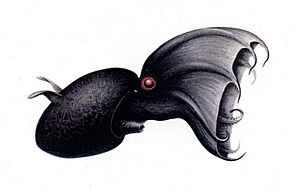Vampyromorphida facts for kids
Quick facts for kids Vampyromorphida |
|
|---|---|
 |
|
| Vampyroteuthis infernalis | |
| Scientific classification | |
| Kingdom: | |
| Phylum: | |
| Class: | |
| Subclass: | |
| Superorder: | |
| Order: |
Vampyromorphida
Pickford, 1939
|
| Suborders | |
|
?†Kelaenina |
|
| Synonyms | |
|
|
Vampyromorphida is a group of amazing ocean animals called cephalopods. This group includes only one living species today: the unique Vampyroteuthis infernalis. Many other species in this group are now extinct, meaning they no longer exist.
Contents
What are Vampyromorphida?
Cephalopods are a type of mollusc, like snails or clams. But cephalopods are special because they have a head and tentacles. The word "cephalopod" means "head-foot." This is because their feet (or tentacles) are attached to their heads.
Vampyromorphida are known for their soft bodies. They do not have a hard shell like some other molluscs. Instead, they have an internal shell that is very small. This helps them move easily in the water.
The Amazing Vampire Squid
The most famous member of the Vampyromorphida is the Vampire Squid. It is not really a squid, but it looks a bit like one. Its scientific name, Vampyroteuthis infernalis, means "vampire squid from hell." This name comes from its dark color and red eyes. It also has a web of skin between its arms.
The Vampire Squid can grow up to about 28 centimeters (11 inches) long. It lives in the very deep parts of the ocean. This area is called the "oxygen minimum zone." Here, there is very little oxygen. The Vampire Squid is one of the few animals that can live in such a harsh environment.
How the Vampire Squid Survives
The Vampire Squid has some cool ways to survive in the deep sea. It has large, glowing eyes that help it see in the dark. It can also make its own light. This is called bioluminescence. It uses light to confuse predators or to attract prey.
When threatened, the Vampire Squid can pull its arms over its head. This creates a spiky, cape-like shape. It looks like a spiny ball, which can scare away attackers. It can also squirt a cloud of glowing mucus instead of ink. This glowing cloud helps it escape.
What Do They Eat?
Unlike many other cephalopods that hunt live prey, the Vampire Squid is a detritivore. This means it eats "marine snow." Marine snow is made of dead tiny plants and animals. It also includes bits of waste that float down from the ocean surface.
The Vampire Squid has two long, sticky filaments. It uses these to catch the marine snow. It then brings the food to its mouth. This way of eating is perfect for its deep-sea home. There is not much live prey available there.
How Are They Classified?
Scientists group living things into different categories. This helps us understand how they are related. The Vampyromorphida is an "order" of animals. This is a big group that includes many families.
Most of the animals in the Vampyromorphida order are extinct. We only know about them from their fossils. These fossils help us learn about ancient ocean life. They show us how these animals have changed over millions of years.
- Order Vampyromorphida
- ?Suborder †Kelaenina
- Family †Muensterellidae
- Suborder †Prototeuthina
- Family †Loligosepiidae
- Family †Plesioteuthididae
- Family †Geopeltididae
- Family †Leptotheuthididae
- Family †Lioteuthididae
- Family †Mastigophoridae
- Suborder †Mesoteuthina
- Family †Palaeololiginidae
- Subfamily †Teudopseinae
- Subfamily †Palaeololigininae
- Family †Trachyteuthididae
- Subfamily †Trachyteuthidinae
- Subfamily †Actinosepiinae
- Family †Palaeololiginidae
- Suborder Vampyromorphina
- Family Vampyroteuthidae
- ?Suborder †Kelaenina
Images for kids
See also
 In Spanish: Vampiromórfidos para niños
In Spanish: Vampiromórfidos para niños



